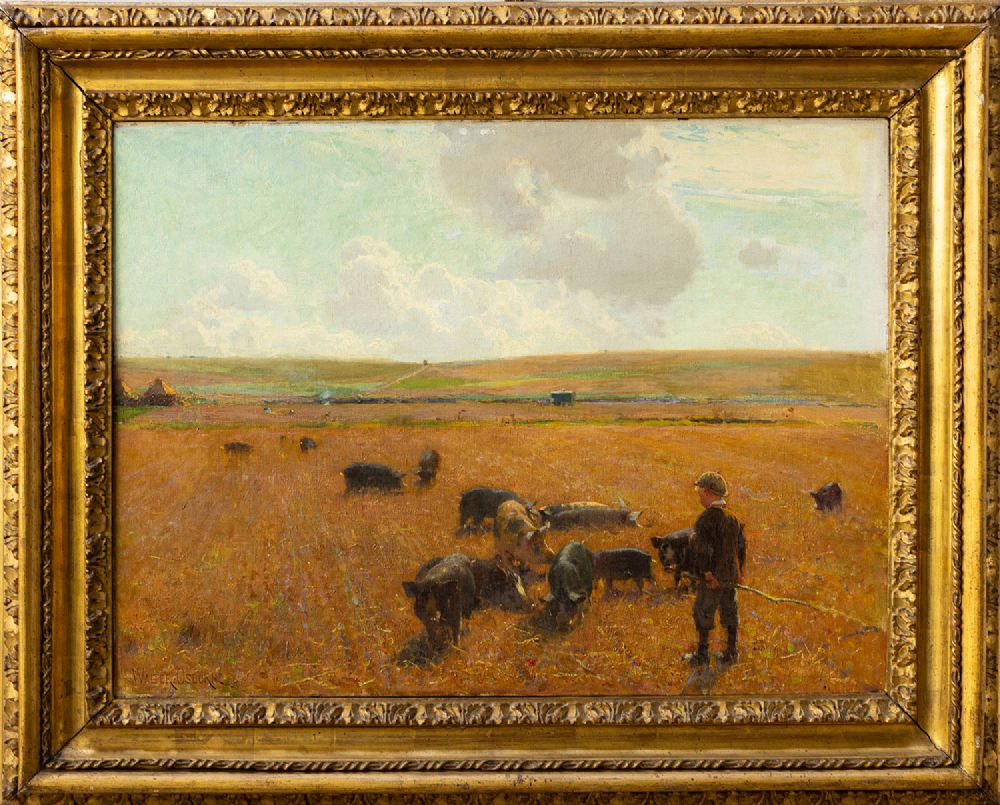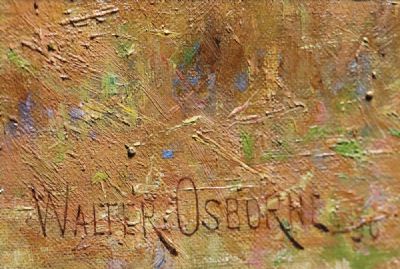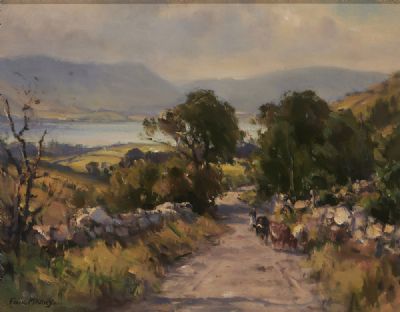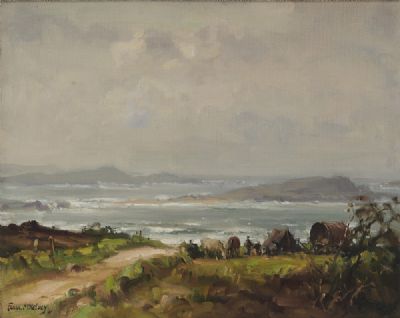Bidding on this item has ended.
Sir Walter Frederick Osborne
JOE THE SWINEHERD, 1890
Lot 32
Price Realised:
€70,000
Estimate:
€80,000 - €120,000
Walter Frederick Osborne RHA, 1859-1903
JOE THE SWINEHERD, 1890
Oil on canvas, 20" x 27" (51 x 68.4cm), signed and dated '1890.
Provenance: Private Collection; Woolley & Wallis, 6th September 2023, no. 487.
Exhibited: London, Royal...
Read more
 Lot 32
Sir Walter Frederick Osborne
JOE THE SWINEHERD, 1890
Lot 32
Sir Walter Frederick Osborne
JOE THE SWINEHERD, 1890
 Lot 32
Sir Walter Frederick Osborne
JOE THE SWINEHERD, 1890
Lot 32
Sir Walter Frederick Osborne
JOE THE SWINEHERD, 1890
Estimate:
€80,000 - €120,000
Walter Frederick Osborne RHA, 1859-1903
JOE THE SWINEHERD, 1890
Oil on canvas, 20" x 27" (51 x 68.4cm), signed and dated '1890.
Provenance: Private Collection; Woolley & Wallis, 6th September 2023, no. 487.
Exhibited: London, Royal Academy, 1891, no.613; Liverpool, Walker Art Gallery, Autumn Exhibition, 1891; Dublin, Royal Hibernian Academy, 1892, no.87; Dublin, National Gallery of Ireland, 16 November-31 December 1983, no.36; Belfast, Ulster Museum, 20 January-29 February 1984, no.36
Literature: Jeanne Sheehy, Walter Osborne, 1974, no.234; Jeanne Sheehy, Walter Osborne exhibition catalogue, 1983, no.36
Osborne completed his art training at the Academie Royale d'Anvers, Antwerp, and then spent a year at the burgeoning artists' colony at Quimperle. Many of the most interesting modern painters were working from life in the open air using local models and the Breton fishing villages were the melting pot where artists from all over Europe exchanged ideas and practices. The rural 'Naturalism' of Jules Bastien-Lepage dominated the approach of many of these artists. Bastien-Lepage's principles and techniques were spreading rapidly and when he returned to London at the end of 1883, Osborne noted with enthusiasm the work of his principal interpreter in Britain, George Clausen.
By the time Osborne painted Joe the swineherd in 1890 he had found his own methods and techniques and was not working in the shadow of any single influence. He returned repeatedly to the theme of a young single foreground figure with an expansive landscape unfolding behind. The figure has nothing to relate to apart from the landscape. This is most impressively seen in the present lot as well as many others from the same period including, Harvest Time (circa 1890, private collection), Boy in a turnip field (1888, private collection), Boy under trees (1887, private collection). The device of the single foreground figure draws the onlooker into the scene and creates an intimacy that would be impossible with a second figure present. His young Wessex subjects such as 'Joe' are the pictorial equivalent to any number of Thomas Hardy characters, dwarfed by their surroundings and circumstances.
The way Osborne paints animals is also worthy of comment, he often crops them in the composition such as in The sheepfold (circa 1885, private collection) which was a major departure from the conventional rules of composition. It is obvious from his extensive drawings that the realistic depiction of animals was a priority for him and his training under Charles Verlat would only have encouraged this inclination. The pigs painted in Joe the swineherd are beautifully painted rooting around their young protector and casting purple shadows on the late summer stubble.
Walter Osborne was fascinated by scenes of rural life and farming. This picture, Joe the Swineherd, is one of a series of atmospheric images of country people and farm hands at work, which he painted in the rural English landscape in the late 1880s and early 1890s. A boy in cap is shown in the foreground, watching over a group of pigs. The figures are vied in shadow, 'au contre jour', casting shadows upon the ground. The stubble fields stretch towards the gentle Downs in the distance, and the scene is lit by a warm golden light, evoking a sense of heat and atmosphere in a late summer or early autumn day. Small figures at work and some animals, a large haystack and a caravan, are visible in the distance and smoke rises from a fire.
The scene may be set in Berkshire, in the Hampshire Downs, or close to Rye in Kent, where Osborne was working in these years. (1)Osborne's choice of subject, whether in Ireland, England, or on the Continent, was influenced not only by the village environment or landscape around him, but also by the availability of models, the boys and girls who agreed to pose for him; the girls in coiffes and aprons in villages in Brittany, for instance; the ragged crop-haired boys in Dublin streets, local children on English farms and in harbour towns; as well as the children of friends in Dublin gardens. In certain cases the particular name of the model has been recorded, giving a sense of intimacy to the subject. Thus, we have, for example, Marie, a Girl In Brittany; Bessie Osborne (no relation to the artist), who modelled for his painting Feeding Chickens, 1884 (2); Michael, a waiter in a hotel in Co. Kerry; Walter Armstrong in the Cafe de Madrid; and here, Joe, the Swineherd.
Osborne painted a series of pictures of people at work in the flat English countryside. These include The Return of the Flock, 1885, A Shepherd and his Flock, 1887, Ploughing, c.1887, Potato Gathering, 1888, Harvest Time, 1890, (3) and Joe the Swineherd, 1890, one of the largest pictures in the series. Like the great French Peasant artists such as Millet and Charles Jacque, and the Dutchman Anton Mauve, who represented humble people and their flocks in an heroic manner, Osborne also observed shepherds and herders with their farm animals, such as horses, cattle, sheep, goats and here, pigs.
During the medieval period belief in the Four Humours and the Four Elements associated the pig with the earth(4). Small groups of pigs grazing were depicted in some Books of Hours, and they appeared occasionally in Dutch and Flemish Genre paintings in the 17th Century.However, pigs appeared rarely in paintings by Barbizon and Realist artists of the 19th Century. The swineherd regarded as a lowly member of society. Yet pigs were featured in some farmyard scenes in Paul Serusier, of the Pont-Aven School, and later in a lively drawing by Picasso. (5)Osborne was thus most original in depicting this humble animal and its minder in their landscape in a Naturalistic and sympathetic manner. He may have been struck, as the present-day visitor to England is, by the large number of pig farms scattered across the countryside (6). He depicts a number of black domestic pigs, one of the common breeds, and a couple of brindled ones (7), conveying well their sociability and curiosity.
Osborne places the figure of the boy in the lower right-hand corner of the picture. He wears a cap over fair hair, and is clad in plain, workday clothes; jacket, breeches and boots. He is viewed from behind, and looks at the pigs and into the landscape. Light falls on the side of his cap, trousers and boots, and shines on the backs of the pigs. The figures are set against the light, and cast mauve shadows upon the stubble field, which is rendered with bold, textured strokes. Osborne employs a rich variety of hues in the landscape: golds, pinks, yellows and lime greens, blues, violets and reds, the Downs in the background are green and pink, conveyed in long brushstrokes, while pale clouds rise above the horizon, gleaming with sunlight, giving a serene mood.
The line of the stick held by the boy, leading into the picture, is counterpointed by a diagonal line on the Downs. From the foreground faint lines lead through the stubble into the distance, giving a sense of perspective to the picture. This perspective, the cropping of the composition, and the kind of glow around the figures, could suggest that Osborne made use of photography in composing his pictures, but this has not been confirmed.
The model for the boy in Joe the Swineherd may appear in other contemporary pictures by Osborne, for example the fair-haired child with cap who rests against the haystacks in Harvest Time, c.1890, (although the latter appears younger), and in The Cornfield, 1890, (Dublin City Gallery The Hugh Lane). Osborne also painted a small study of Joe the Swineherd, which he exhibited at the Dublin Art Club in 1891. The forms of the pigs are echoed in a delightful pencil study of pigs sketched in Roundstone, Co. Galway in 1897 (8).The present picture of Joe the Swineherd was exhibited at several venues shortly after its completion: at the Royal Academy, London and at the Autumn Exhibition, Liverpool, in 1891 and at the Royal Hibernian Academy, Dublin the following year. It appears to have remained unsold at these venues, and Stephen Gwynn suggests that it remained in the artist's collection during his lifetime (8) (and perhaps reminding him (Osborne) of his happy youthful days painting in the countryside in sunshine). In 1983 the painting was included in the large Walter Osborne exhibition curated by Jeanne Sheehy, and held at the National Gallery of Ireland, Dublin. Dr Julian Campbell.
FOOTNOTES:
1. Jeanne Sheehy Walter Osborne, Ballycotton, 1974, p.28;
2. Donal Maguire, 'A Letter from Walter Osborne', Irish Arts Review, Spring 2016, p.144
3. J. Sheehy, 1974, cat. nos. 128, 152, 154, 180, 236 and 234; respectively, Irish Sale, Christie's, 15 May 2003, lot 37; J. Sheehy, Walter Osborne, 1983, cat. no. 26Important Irish Art, Adam's, 5 Dec. 2001, lot 41;Important Irish Art, Adam's, 4 Dec. 2015, lot 69;Important Irish Art, Adam's/Bonham's, 29 May 2002, lot 41;
4. James Hall, Dictionary of Subjects and Symbols in Art, 1979 edition, p.130.
5. eg. Paul Serusier, Breton Woman Feeding Pigs. (Musee departmen de Prieure, Saint-Germain-en-Laye; Picasso, Pigs, c.1906 (Succession Picasso).
6. However, some native breeds of pig are in decline in Britain, Country Life, 18 Feb. 2015, p.26.
7. Stephen Gwynn described the animals in Osborne's pictures as 'black Berkshire yearlings'. Gwynn, Garden Wisdom, 1921, p.30.
8. W. Osborne, Pig Studies, Roundstone, 1897, Important Irish Art, Adam's, 4 Dec. 2012 lot 67. Compare to Picasso's drawing Pigs, (see note 5, above).
(I am grateful to George Mealy, Snr, and Cait Madigan, Mealy's Castlecomer, for assistance in my research).
JOE THE SWINEHERD, 1890
Oil on canvas, 20" x 27" (51 x 68.4cm), signed and dated '1890.
Provenance: Private Collection; Woolley & Wallis, 6th September 2023, no. 487.
Exhibited: London, Royal Academy, 1891, no.613; Liverpool, Walker Art Gallery, Autumn Exhibition, 1891; Dublin, Royal Hibernian Academy, 1892, no.87; Dublin, National Gallery of Ireland, 16 November-31 December 1983, no.36; Belfast, Ulster Museum, 20 January-29 February 1984, no.36
Literature: Jeanne Sheehy, Walter Osborne, 1974, no.234; Jeanne Sheehy, Walter Osborne exhibition catalogue, 1983, no.36
Osborne completed his art training at the Academie Royale d'Anvers, Antwerp, and then spent a year at the burgeoning artists' colony at Quimperle. Many of the most interesting modern painters were working from life in the open air using local models and the Breton fishing villages were the melting pot where artists from all over Europe exchanged ideas and practices. The rural 'Naturalism' of Jules Bastien-Lepage dominated the approach of many of these artists. Bastien-Lepage's principles and techniques were spreading rapidly and when he returned to London at the end of 1883, Osborne noted with enthusiasm the work of his principal interpreter in Britain, George Clausen.
By the time Osborne painted Joe the swineherd in 1890 he had found his own methods and techniques and was not working in the shadow of any single influence. He returned repeatedly to the theme of a young single foreground figure with an expansive landscape unfolding behind. The figure has nothing to relate to apart from the landscape. This is most impressively seen in the present lot as well as many others from the same period including, Harvest Time (circa 1890, private collection), Boy in a turnip field (1888, private collection), Boy under trees (1887, private collection). The device of the single foreground figure draws the onlooker into the scene and creates an intimacy that would be impossible with a second figure present. His young Wessex subjects such as 'Joe' are the pictorial equivalent to any number of Thomas Hardy characters, dwarfed by their surroundings and circumstances.
The way Osborne paints animals is also worthy of comment, he often crops them in the composition such as in The sheepfold (circa 1885, private collection) which was a major departure from the conventional rules of composition. It is obvious from his extensive drawings that the realistic depiction of animals was a priority for him and his training under Charles Verlat would only have encouraged this inclination. The pigs painted in Joe the swineherd are beautifully painted rooting around their young protector and casting purple shadows on the late summer stubble.
Walter Osborne was fascinated by scenes of rural life and farming. This picture, Joe the Swineherd, is one of a series of atmospheric images of country people and farm hands at work, which he painted in the rural English landscape in the late 1880s and early 1890s. A boy in cap is shown in the foreground, watching over a group of pigs. The figures are vied in shadow, 'au contre jour', casting shadows upon the ground. The stubble fields stretch towards the gentle Downs in the distance, and the scene is lit by a warm golden light, evoking a sense of heat and atmosphere in a late summer or early autumn day. Small figures at work and some animals, a large haystack and a caravan, are visible in the distance and smoke rises from a fire.
The scene may be set in Berkshire, in the Hampshire Downs, or close to Rye in Kent, where Osborne was working in these years. (1)Osborne's choice of subject, whether in Ireland, England, or on the Continent, was influenced not only by the village environment or landscape around him, but also by the availability of models, the boys and girls who agreed to pose for him; the girls in coiffes and aprons in villages in Brittany, for instance; the ragged crop-haired boys in Dublin streets, local children on English farms and in harbour towns; as well as the children of friends in Dublin gardens. In certain cases the particular name of the model has been recorded, giving a sense of intimacy to the subject. Thus, we have, for example, Marie, a Girl In Brittany; Bessie Osborne (no relation to the artist), who modelled for his painting Feeding Chickens, 1884 (2); Michael, a waiter in a hotel in Co. Kerry; Walter Armstrong in the Cafe de Madrid; and here, Joe, the Swineherd.
Osborne painted a series of pictures of people at work in the flat English countryside. These include The Return of the Flock, 1885, A Shepherd and his Flock, 1887, Ploughing, c.1887, Potato Gathering, 1888, Harvest Time, 1890, (3) and Joe the Swineherd, 1890, one of the largest pictures in the series. Like the great French Peasant artists such as Millet and Charles Jacque, and the Dutchman Anton Mauve, who represented humble people and their flocks in an heroic manner, Osborne also observed shepherds and herders with their farm animals, such as horses, cattle, sheep, goats and here, pigs.
During the medieval period belief in the Four Humours and the Four Elements associated the pig with the earth(4). Small groups of pigs grazing were depicted in some Books of Hours, and they appeared occasionally in Dutch and Flemish Genre paintings in the 17th Century.However, pigs appeared rarely in paintings by Barbizon and Realist artists of the 19th Century. The swineherd regarded as a lowly member of society. Yet pigs were featured in some farmyard scenes in Paul Serusier, of the Pont-Aven School, and later in a lively drawing by Picasso. (5)Osborne was thus most original in depicting this humble animal and its minder in their landscape in a Naturalistic and sympathetic manner. He may have been struck, as the present-day visitor to England is, by the large number of pig farms scattered across the countryside (6). He depicts a number of black domestic pigs, one of the common breeds, and a couple of brindled ones (7), conveying well their sociability and curiosity.
Osborne places the figure of the boy in the lower right-hand corner of the picture. He wears a cap over fair hair, and is clad in plain, workday clothes; jacket, breeches and boots. He is viewed from behind, and looks at the pigs and into the landscape. Light falls on the side of his cap, trousers and boots, and shines on the backs of the pigs. The figures are set against the light, and cast mauve shadows upon the stubble field, which is rendered with bold, textured strokes. Osborne employs a rich variety of hues in the landscape: golds, pinks, yellows and lime greens, blues, violets and reds, the Downs in the background are green and pink, conveyed in long brushstrokes, while pale clouds rise above the horizon, gleaming with sunlight, giving a serene mood.
The line of the stick held by the boy, leading into the picture, is counterpointed by a diagonal line on the Downs. From the foreground faint lines lead through the stubble into the distance, giving a sense of perspective to the picture. This perspective, the cropping of the composition, and the kind of glow around the figures, could suggest that Osborne made use of photography in composing his pictures, but this has not been confirmed.
The model for the boy in Joe the Swineherd may appear in other contemporary pictures by Osborne, for example the fair-haired child with cap who rests against the haystacks in Harvest Time, c.1890, (although the latter appears younger), and in The Cornfield, 1890, (Dublin City Gallery The Hugh Lane). Osborne also painted a small study of Joe the Swineherd, which he exhibited at the Dublin Art Club in 1891. The forms of the pigs are echoed in a delightful pencil study of pigs sketched in Roundstone, Co. Galway in 1897 (8).The present picture of Joe the Swineherd was exhibited at several venues shortly after its completion: at the Royal Academy, London and at the Autumn Exhibition, Liverpool, in 1891 and at the Royal Hibernian Academy, Dublin the following year. It appears to have remained unsold at these venues, and Stephen Gwynn suggests that it remained in the artist's collection during his lifetime (8) (and perhaps reminding him (Osborne) of his happy youthful days painting in the countryside in sunshine). In 1983 the painting was included in the large Walter Osborne exhibition curated by Jeanne Sheehy, and held at the National Gallery of Ireland, Dublin. Dr Julian Campbell.
FOOTNOTES:
1. Jeanne Sheehy Walter Osborne, Ballycotton, 1974, p.28;
2. Donal Maguire, 'A Letter from Walter Osborne', Irish Arts Review, Spring 2016, p.144
3. J. Sheehy, 1974, cat. nos. 128, 152, 154, 180, 236 and 234; respectively, Irish Sale, Christie's, 15 May 2003, lot 37; J. Sheehy, Walter Osborne, 1983, cat. no. 26Important Irish Art, Adam's, 5 Dec. 2001, lot 41;Important Irish Art, Adam's, 4 Dec. 2015, lot 69;Important Irish Art, Adam's/Bonham's, 29 May 2002, lot 41;
4. James Hall, Dictionary of Subjects and Symbols in Art, 1979 edition, p.130.
5. eg. Paul Serusier, Breton Woman Feeding Pigs. (Musee departmen de Prieure, Saint-Germain-en-Laye; Picasso, Pigs, c.1906 (Succession Picasso).
6. However, some native breeds of pig are in decline in Britain, Country Life, 18 Feb. 2015, p.26.
7. Stephen Gwynn described the animals in Osborne's pictures as 'black Berkshire yearlings'. Gwynn, Garden Wisdom, 1921, p.30.
8. W. Osborne, Pig Studies, Roundstone, 1897, Important Irish Art, Adam's, 4 Dec. 2012 lot 67. Compare to Picasso's drawing Pigs, (see note 5, above).
(I am grateful to George Mealy, Snr, and Cait Madigan, Mealy's Castlecomer, for assistance in my research).
- Enquire
- View all lots by this artist
- How bidding works
Please note: You will require a deVeres account in order to bid. Please register via the website. Each lot will close numerically. If there is late bidding the time may be extended which could delay subsequent lots. The lots will start to close from 2.00pm on auction day, closing at 45 second intervals.
PLEASE BID EARLY TO AVOID DISAPPOINTMENT.
In order to allow rival bidders the opportunity to respond to a late bid the following extensions will apply:
IF A BID IS RECEIVED WITHIN THE FINAL 45 SECONDS OF THE COUNTDOWN THE CLOCK WILL RESET TO 60 SECONDS.
At any point you can leave a maximum bid, representing the highest price you are prepared to pay for a particular lot. Bidding only advances when there is competition from a rival bidder. In that case the system bids on your behalf, only up to the maximum if required. All bids are relayed to you be email, along with notification if you have been outbid.
All maximum bids are confidential and not disclosed. The system will endeavor to purchase the lot for you for the least price. Bids are subject to buyer’s premium of 25% (incl vat), with no additional charges.
In the event of a tied bid, the preference will be given to the bid submitted first. The second bidder will receive immediate notification of being outbid.
PLEASE BID EARLY TO AVOID DISAPPOINTMENT.
In order to allow rival bidders the opportunity to respond to a late bid the following extensions will apply:
IF A BID IS RECEIVED WITHIN THE FINAL 45 SECONDS OF THE COUNTDOWN THE CLOCK WILL RESET TO 60 SECONDS.
At any point you can leave a maximum bid, representing the highest price you are prepared to pay for a particular lot. Bidding only advances when there is competition from a rival bidder. In that case the system bids on your behalf, only up to the maximum if required. All bids are relayed to you be email, along with notification if you have been outbid.
All maximum bids are confidential and not disclosed. The system will endeavor to purchase the lot for you for the least price. Bids are subject to buyer’s premium of 25% (incl vat), with no additional charges.
In the event of a tied bid, the preference will be given to the bid submitted first. The second bidder will receive immediate notification of being outbid.
Sign-up to our auction alert
Signup for personalised Irish art recommendations, invitations to viewings and auctions, articles and more.



 View More Videos
View More Videos DVTV Click Here To View Video
DVTV Click Here To View Video


